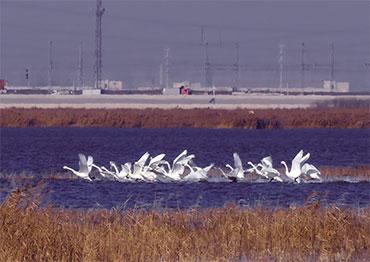The East Asia-Australasian Flyway passes through China’s population-dense and economically developed eastern coast. As urban areas expanded, there was constant reclamation and occupation of wetlands, Zhang said. According to a journal paper titled “Lessons from Development of the US West to China’s ‘Go-West’ Campaign” published for Resources Science in November 2015, similar to the situation in the US in the 19th century when wetland reclamation, cultivation and crop planting were encouraged, 90 percent of the wetlands (up to tens of millions of hectares) in the western US were converted into farmland and residential land, which resulted in severe biodiversity damage.
In 1992, China joined the Convention on Wetlands of International Importance Especially as Waterfowl Habitat (Ramsar Convention), which was regarded as a turning point for wetland protection in China. Before that, there was no concept of wetlands in Chinese research communities. Zhang said the Ramsar Convention requires states to identify their wetland resources, so the State Forestry Administration organized a national wetland resources survey from 1995 to 2003 and a second one from 2009 to 2013. According to Zhang, who took part in both, the surveys showed China’s wetlands were increasingly under threat. Statistics showed their total area decreased by 8.82 percent between the first and second survey, and coastal wetlands in 11 provinces decreased by 21.91 percent.
In December 2016, the State Council issued the Plan for Wetland Protection and Restoration System, which proposed a red line area for inland and coastal wetlands of a minimum 800 million mu (53.3m hectares) by 2020, based on the second wetland survey results. According to statistics released in August 2021, China’s total wetland area remains over 800 million mu (53.3m hectares). Sixty-four wetlands in China are listed as Wetlands of International Importance. In addition, China has set up 602 wetland nature reserves and over 1,600 wetland parks. In 2003, the State Council issued the National Wetland Protection Project Plan (2002-2030), which includes three five-year implementation plans. The central government invested 19.8 billion yuan (US$3.13b) in over 4,100 projects to encourage local governments to carry out wetland ecological protection and restoration. In 2021, China introduced its first-ever Wetland Protection Law, and all provinces, autonomous regions and municipalities issued wetland protection regulations. The law takes effect on June 1, 2022.
From November 21 to 29, China will host the 14th Meeting of the Conference of the Contracting Parties to the Ramsar Convention on Wetlands (COP14) in Wuhan, capital of Central China’s Hubei Province. Zhang Mingxiang said that 2021 marks the 50th anniversary of China’s signing of the Ramsar Convention, but speeding up wetland protection legislation is needed to implement the convention.
Zhang added that when drafting the Wetland Protection Law, lawmakers took into consideration how effective restoration projects will be. “Sometimes good intentions do not mean making things good, not to mention when people do things just in the name of good intentions,” Zhang said. Part of the law is designed specifically for wetland restoration, stating that important projects will be submitted to provincial forestry and grassland departments, which will consider the opinions of other departments, including water resources, environment, agriculture and housing. Failing to abide by the law will incur fines from 100,000 yuan (US$15,720) up to 1 million yuan (US$157,200).
In Zhang Mingxiang’s opinion, a good wetland restoration project should identify existing ecological problems and determine their causes, such as water shortages, pollution or alien species invasion, before conducting restoration activities.
Wen Cheng believes biodiversity should be an important indicator of restoration. “In the planning and design stage, biodiversity conservation should be the goal. The designer and contractor should clearly understand which common species and which rare and endangered species live or once lived in the project’s location. In the planning and design process, there should be specific and measurable indicators of biodiversity restoration after the project. To be more specific, we need to know which species we should engineer restoration solutions for to ensure their numbers don’t fall further, and what solutions we should engineer to allow reintroduction and preservation of species when the project is done. We can then use these indicators to test whether the project is successful,” Wen said.
Ensuring the proper use of funds earmarked for ecological restoration takes strict referral to scientific information, establishing standardized technical specifications, and tracking and evaluating biodiversity results, Wen added.

 Old Version
Old Version

